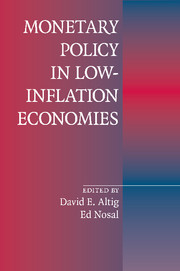Book contents
- Frontmatter
- Contents
- Contributors
- Acknowledgments
- Introduction
- 1 The Welfare Cost of Inflation in the Presence of Inside Money
- Commentary
- 2 An Open-Economy Model of Endogenous Price Flexibility
- Commentary
- 3 Efficient Inflation Targets for Distorted Dynamic Economies
- Commentary
- 4 Inflation and Welfare in Models with Trading Frictions
- Commentary
- 5 Good versus Bad Deflation: Lessons from the Gold Standard Era
- Commentary
- 6 Monetary Policy Orientation in Times of Low Inflation
- Commentary
- 7 Observations on Disinflation in Transition Economies
- Commentary
- 8 Inflation and Financial Market Performance: What Have We Learned in the Last Ten Years?
- Commentary
- Index
Commentary
Published online by Cambridge University Press: 26 January 2010
- Frontmatter
- Contents
- Contributors
- Acknowledgments
- Introduction
- 1 The Welfare Cost of Inflation in the Presence of Inside Money
- Commentary
- 2 An Open-Economy Model of Endogenous Price Flexibility
- Commentary
- 3 Efficient Inflation Targets for Distorted Dynamic Economies
- Commentary
- 4 Inflation and Welfare in Models with Trading Frictions
- Commentary
- 5 Good versus Bad Deflation: Lessons from the Gold Standard Era
- Commentary
- 6 Monetary Policy Orientation in Times of Low Inflation
- Commentary
- 7 Observations on Disinflation in Transition Economies
- Commentary
- 8 Inflation and Financial Market Performance: What Have We Learned in the Last Ten Years?
- Commentary
- Index
Summary
INTRODUCTION
Central bankers are wont to ask their staff questions such as, “Is deflation good or bad?” Economists are wont to respond that the question is not well posed. Prices, they like to say, are endogenous, like quantities. Whether a fall in prices is good or bad depends on what causes it and what that cause does to quantities. Thus, the central banker's worry about deflation needs to be formulated as, “So what causes deflation, and what does it do to GDP?”
Why are central bankers (and the public in general) so worried about deflation? Modern economies offer few examples, and two are particularly well known. One is the Great Depression in the United States in the 1930s, which saw prices fall by 24% and GDP fall by 25% from 1929 to 1932. The other is Japan between 1998 and 2002, when prices fell by 1.6% on average while GDP grew only 1%. Because two points are enough to draw a line, these two instances probably account for deflation's bad reputation. But there are other examples, without having to reach far back into a past plagued by a scarcity of data. The period of the classical gold standard, from 1873 to 1913, in fact provides us with worldwide deflation followed by worldwide inflation—not quite a controlled experiment, but at least the economies were comparable if not identical in these adjacent time periods. And, at first blush, there does not seem to be much evidence for the malign effects of deflation compared to inflation.
- Type
- Chapter
- Information
- Monetary Policy in Low-Inflation Economies , pp. 175 - 180Publisher: Cambridge University PressPrint publication year: 2009



